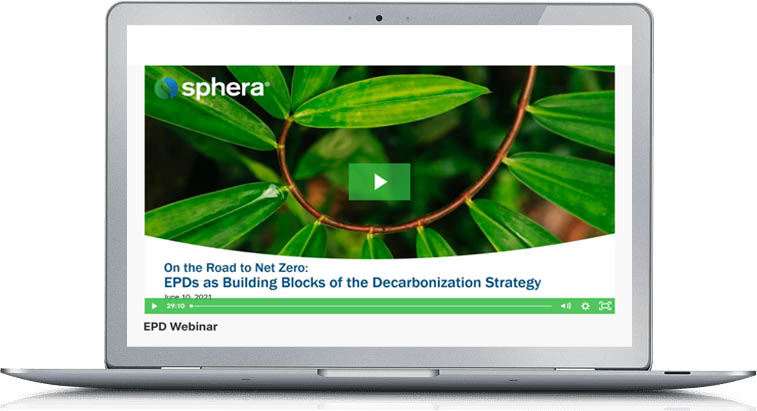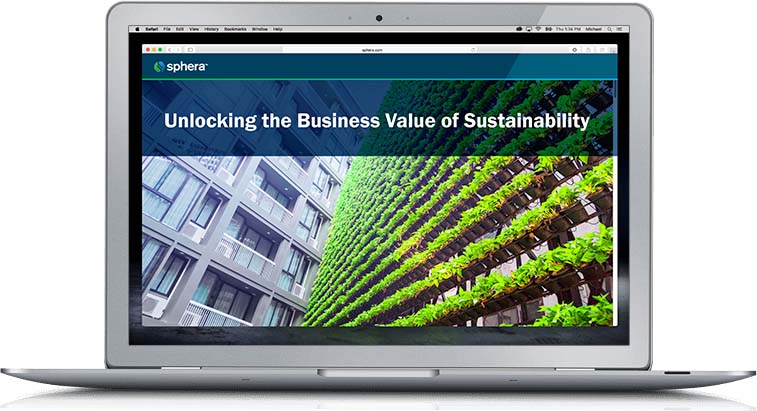Join Sphera Content Marketing Manager Rachel Popa; Julia Goerke, a Sphera consulting director; and Robert Spang, a Sphera consulting manager, as they discuss environmental product declarations (EPDs), related regulations and the role of automation in conducting EPDs.
The following transcript was edited for style, length and clarity.
Rachel Popa:
Welcome to the SpheraNOW ESG podcast, a program focused on safety, sustainability and productivity topics. I’m Rachel Popa, one of Sphera’s content marketing managers. Today we’re joined by Julia Goerke, a consulting director at Sphera, and Robert Spang, a consulting manager at Sphera. Before we get started, would you both introduce yourselves to our listeners?
Julia Goerke:
Hello Rachel. It’s great to be on this podcast. My name is Julia Goerke. I’m leading the construction team here at Sphera, and I’m based in Germany. Another role that I have is that I’m convener of a European standardization body for life cycle assessments of construction products, the so-called environmental product declarations.
Robert Spang:
Hello everybody, my name is Robert Spang. I’ve worked at Sphera for around 10 years in the building and construction team, and I’m responsible for semi-automated and automated EPD tools here at Sphera.
Rachel Popa:
Great, thank you both for joining me on the podcast. In this episode, we’ll be focusing on environmental product declarations, otherwise known as EPDs, the regulations surrounding them and how EPD and life cycle assessment automation, combined with reliable data, can improve the process.
To set the stage, the buildings and construction sector is responsible for approximately 37% of CO2 emissions that stem from energy and processes, according to a report from the United Nations Environment Programme’s Global Alliance for Buildings and Construction. Due to the size of its carbon footprint, the decarbonization of the buildings and construction sector will be essential to meeting climate goals. So, to that end, there are regulations in both the U.S. and EU that require more transparent reporting on the carbon footprint of buildings and construction materials.
So, Julia, can you describe the regulations that those in the buildings and construction industry should be aware of?
Julia Goerke:
So, in northern countries and middle Europe, we are spending around 90% of our time in buildings, and it is clear that everyone wants to live in a safe and healthy environment. That’s why there are many regulations for construction works in place to protect occupants, workers and consumers.
Today, these regulations focus on safety and performance requirements, such as a product’s reaction and resistance to fire, mechanical resistance and stability, protection against noise or good indoor air quality.
Rachel Popa:
So, Julia, as a regulatory expert, how do you see these regulations playing out in the coming years? What types of regulations do you think the buildings and construction industry should expect in the future?
Julia Goerke:
Yes, now let’s discuss the environmental part of the picture. Rachel, you’ve already mentioned that buildings account for nearly 40% of global greenhouse gas emissions. This covers all life cycle stages, from cradle to grave of a building, including the manufacturing of the construction products, the construction of the building, the use phase (the energy for heating and cooling, etc.) and the final demolition.
The mitigation of these impact aspects—like circularity, recycling and the sustainable use of natural resources—is most important to meet the climate goal. We see that policymakers are integrating these aspects into the regulations. In the European Union, for instance, the construction product regulation is under revision and will include the green aspects, and in this context, we see the need to declare the carbon footprint of a product.
Rachel Popa:
What are some of the challenges companies are currently facing in complying with these regulations?
Julia Goerke:
Companies need to understand their products from a life cycle perspective, and they need to understand what the carbon footprint of their products is. This is the new world and the new perspective, but it is crucial to define a way toward net zero. Thus, the construction industry is in transition at the moment, and they are figuring out the necessary actions to reduce the environmental impact.
This might be the material choice or the energy choice, and this exercise requires constant monitoring of your carbon footprint to stay on the path toward net zero.
Rachel Popa:
Excellent. Thanks for that background, Julia. Now that we’ve set the stage for the regulations and the challenges that companies are currently facing in complying with them, Robert, how can companies determine the carbon footprint of their materials?

Robert Spang:
Yeah, thanks for asking. Quantitative information on the environmental performance of a product, like the carbon footprint, is calculated based on a life cycle assessment, or LCA. But unlike the carbon footprint, which only quantifies the manufacturing stage, construction product manufacturers are required to analyze the whole life cycle, which is manufacturing, use stage, end of life and loads and benefits beyond the system boundaries.
This information is usually published in environmental product declarations. Because LCAs for EPDs analyze all input and output streams along the entire supply chain, and throughout the life cycle of a product or a product system, it’s obvious that a lot of data is processed.
Rachel Popa:
So, you mentioned data there. What type of data, expertise and solutions do companies need to comply with regulations and decarbonize?
Robert Spang:
The complexity of the subject is quite high. Companies can either externalize or build knowledge internally. But in any case, deep knowledge about LCA and related standards is required, as well as data and software. Today, LCAs and EPDs are not directly mandatory for construction product manufacturers. But, of course, regulations on the corporate level, the pressure from the market toward transparency on the product level and legal requirements on the building level in some European countries are pushing most construction product manufacturers on a journey toward implementation of sustainability-related activities. So, it’s one of our main tasks to consult companies to identify the best way forward.
This includes questions like: What is the best way to cover our product portfolio with EPDs? Is it better to do a manual life cycle assessment, a semi-automated LCA calculator or implement a fully automated LCA solution?
My experience over the last decade is that there are no standard answers to such questions. Every company is in a unique situation, and the specific frame conditions need to be considered. We usually do that in a dedicated scoping phase, where we include many different aspects in our analysis. The main goal is to enable our clients to make an informed decision based on the results of the analysis.
Rachel Popa:
This is a very complex process. What role could automation play in conducting EPDs?
Robert Spang:
Automation allows companies to reduce time and costs per document created to an absolute minimum. This is particularly relevant if a large number of documents must be created. We clearly see a trend toward product- and project-specific EPDs. These are more accurate and support as-built evaluations on the building level.
For many product groups, EPDs will be created and delivered very similarly to the individual invoice for each order. And, just like invoices, which are created automatically on the basis of internal data management systems, EPDs will be too.
Rachel Popa:
To wrap up here, what are some key takeaways or action items from this conversation that you think our audience should focus on?
Julia Goerke:
First, I want to thank you for inviting us to this podcast. And as my final statement, the construction industry is in a transition toward decarbonization. The goal—carbon neutral—is clear, and to reach this goal, the industry needs to monitor the carbon footprint on a regular basis.
Robert Spang:
That’s right, Julia. And besides monitoring, the overall environmental performance of construction products and buildings needs to be improved. I think we are entering that period, in the Northern Hemisphere at least. Redesign, renovation and recycling will play a major role for businesses in the construction sector, both on the building and product level. This will affect many stakeholders throughout the various supply chains, and it’ll require digital solutions to manage and effectively use quantitative environmental information to exploit the full potential.
Rachel Popa:
Great. I think you both gave our listeners a lot to think about, so thank you both again for your input here and for joining me on the SpheraNOW ESG podcast.











